DIVING FROM A BOAT
Return to the Deep-Six Home Page
Return to INDEX of the textbook
Travel is fatal to prejudice. - Mark Twain
Diving from a boat is exciting. Doing a drift dive with the boat following on the surface, going to a spectacular wreck, or just getting away from the shallow water near the shore are reasons enough to pay less than $100 for 2 dives from a boat.
Boat diving can be dangerous unless all the divers know the proper procedures to follow. Each boat is different and each captain has set certain rules to be followed to make the dives fun. It is important to get aboard the vessel on time and listen to the briefing the captain or Divemaster gives to the divers. To wait to find the life jackets, fire suppression-apparatus, or the life-saving oxygen during an emergency, to jump into the water prior to the captain shouting something like "Dive! Dive! Dive!", or not being aware of a current that was announced during the briefing is inexcusable. You should not be talking to your fellow divers, assembling gear, in a position to be unable to hear clearly when the boat diving directions are spelled out. It still applies to those that have been on the boat before.
Boats for scuba come in many different forms. I have done many ocean and lake dives from a sit-on-top kayak. Dives from row boats, canoes, small ski boats, open larger vessels, and the larger (typical) dive vessels have added to my training and enjoyment. Some vessels are so small all the heavy gear is placed in the water, usually tethered to the boat and then the stuff donned in the water. Because most of the students from Deep-Six will be diving from the typical scuba charter we will concentrate on that.
The above are the dive and fishing boats docked in West Palm Beach, Florida
The dive boat is on the left and a fishing boat on the right in WPB
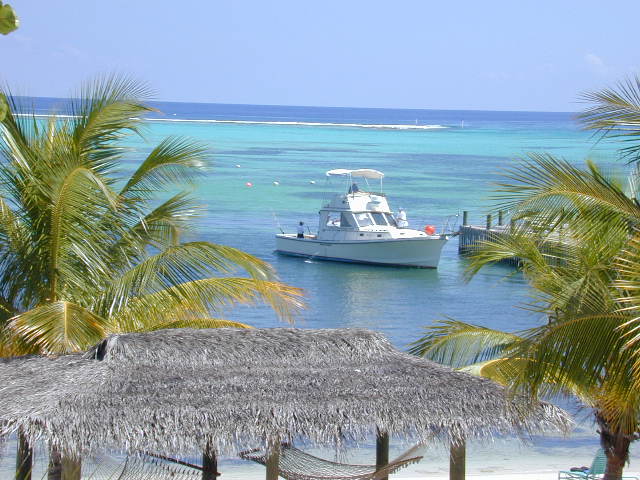
This Caribbean boat was anchored away from the dock at night to free up dock space and prevent entry that is not authorized. In the morning the crew will bring it to dockside before the divers arrive to board. They may load all the tanks that will be needed for the planned morning dives.
A few of the divers have arrived at the dive boat for 2 morning dives. Notice that the crew has positioned only their own BC's on a few tanks. Inside there are more tanks securely attached to the boat side above the seat. Toward the stern is a large orange float attached to a floating yellow line that will be cast into the water when the divers have finished their dive. When the divers surface they may use that line to return to the boat.
Awaiting the arrival of more tanks, the ice for the cooler, and other dive needs allows the divers to chat dockside. Their feet are either bare or they are wearing appropriate attire. Rubber soled sandals, sneakers, or wet suit boots keep one from slipping, getting splinters, prevent burning by hot beach sand, and can get wet. Some of the tanks on the boat have been claimed. The divers' BC's are on every other one. Both tanks have been checked by each diver to be sure they are full. The SPG on the regulator is used to do that.
There are forms to be signed. The divers' manifesto will have a place for your name. It may also have spaces for the number of dives you've done, your address, your certification level, etc. Some dive boats will want to see proof of certification. Some do not care as long as you state it in writing. There will be liability sheet(s) to reduce the risk incurred by the captain and his business. On week-long trips with the same dive boat all the paper work is done before the 1st dive. As you will note in the above the area for filling out the paper work is kept dry.
In the lower right is the drink cooler. The drinks are important to keep divers from dehydration which increases the risk of decompression sickness. The "Drinks Only" is to prevent people from refrigerating their own food. Also it is a reminder to not return the empty cans to the cooler. Trash containers are securely held in place. Did you notice the fire extinguisher? Look for it whenever you board a boat. The dive bags and weight belts are stowed under the benches to keep the aisle clear.
The roster with all the divers' names will be used to be sure everyone has climbed aboard after the dive so no one is left in the water when the boat departs. On this dive boat the hatch to the right leads to the head, extra dive gear, emergency oxygen and dry snacks.
Divers are getting their tanks ready to dive. Notice the tanks are tethered to the boat's hardware. The bungee must be removed in order to put the BC strap and regulator on the tank. Once those items are attached the tank must be re-secured to the boat. On one observed occasion a diver failed to secure the tank and it fell to the deck when the boat was underway in heavy seas. The regulator yolk was bent and it was no longer serviceable. That was quite a costly mistake but it could have been worse if the tank had caused injury. It is best to get the tank, BC, and regulator ready while the boat is in calm water at the dock.
The boat is about to get underway to the dive site. You do not see any computers, regulators, gauges, cameras, or other items hanging from the tanks and resting on the bench or below it. All of those items are put inside the BC or the BC pockets so they are not damaged by severe pounding in rough water. The one dive bag on the floor will be placed under the bench so it will not be sliding all over the boat.
Getting underway. Many times the boat will travel in quiet waters prior to entering the ocean. During that time it might be a good idea to put on the wet or dry suit and get other items ready for the plunge. Waiting for the quiet water on the return allows safer and easier suit removal.
Notice everything is securely stored. There is a net across the stern of this boat to keep loose items from skidding across the deck and off the stern in heavy seas. It also prevents passengers from standing on the swim platform while the boat is moving.
One of the divers is catching some sleep while avoiding the sun's brutal radiation from the sky and from the reflective ocean.
Back Roll (Dive Training Magazine):
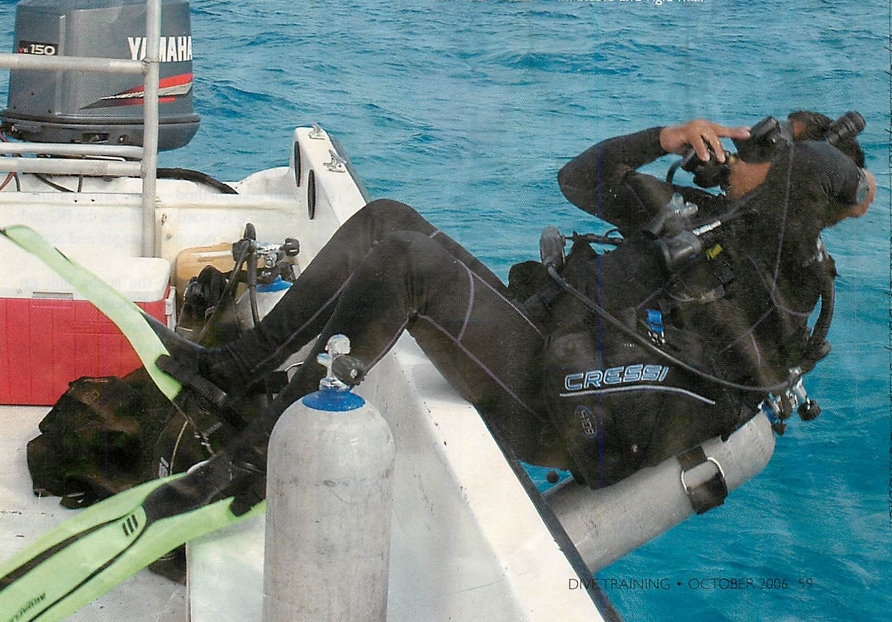
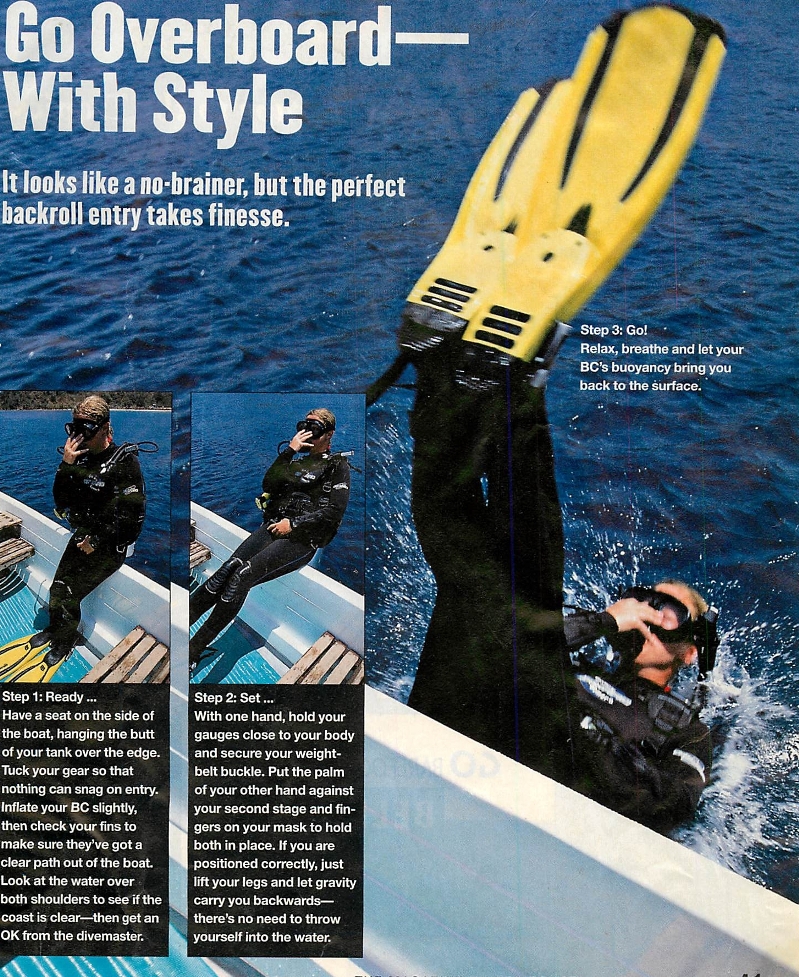
The Giant Stride:
The divers have arrived at the dive site. The boat may be anchored or it may drift. In either case the divers will usually leave the stern with a Giant Stride or a Back Roll. A buddy check (or self-check) was done: Check to see if the weights are on, look at the SPG, and push the power inflator on the BC. (If that gauge drops the tank is not fully on! If nothing happens the BC hose may not be fully attached.) Before entry the diver should put some air in the BC, put the regulator in the mouth, hold the mask and enter the water. Immediately after entry it is a good idea to give the OK signal to the captain. When the buddy enters descend immediately.
This diver is ready to do a Giant Stride and is waiting for her buddy to clear the area. Hold that mask with your palm over its glass to prevent loss or breakage. Forget about holding the regulator. Your teeth do that.
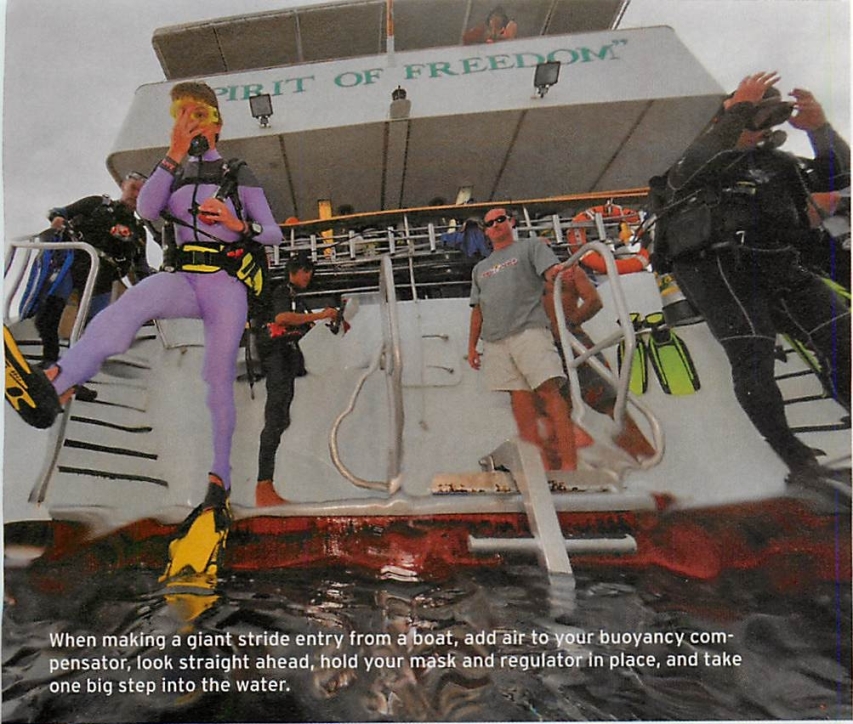

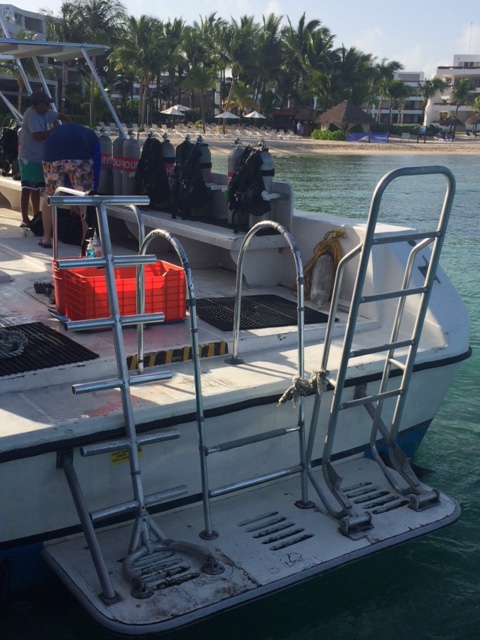
Photo provided by James Meyer
The divers are surfacing with their buddies. The float and flag, or a safety sausage will be necessary in heavy seas in order for the captain to spot each team, especially in a drift dive. The divers should give the OK signal after being spotted and then wait for a pick up or swim to the anchored boat. Leave your mask on and in heavy seas breathe from your regulator. Make sure you following the directions given to you prior to the dive. Most of the time in a drift dive the captain will bring the boat to the dive team and then bring the stern up close for boarding. DO NOT SWIM TOWARD THE BOAT UNLESS INSTRUCTED TO DO SO!
The stern of a boat is a dangerous place unless you follow precautions. If the boat is bouncing up and down in the waves and you grab the swim platform the boat may go up and you may go under the platform. When the boat comes down the platform may smash into your head. If you try to grab the ladder it may be going up and down with such force you will be thrashed about. Under those conditions grabbing the line attached to the buoy will allow you to take off your fins and pull yourself to the ladder. Hand your fins up to the Divemaster, grab the ladder, get on it immediately and start up. Your weight will cause the ladder to stop violent swings.
The diver is getting on to the ladder. The Divemaster has taken the fins and is holding the line attached to the float away from the exiting diver. If you are waiting for another diver to climb the ladder do not get under them. If they should fall off the ladder the target will be you.
Notice the mask is still on and the mouthpiece is still in. It is important to hold on to the ladder. If you fall in without fins the captain will probably have to start the boat and pick you up since a diver without fins can do little to fight even a mild current. If that were to happen immediately inflate your BC and wait on the surface.
The diver is almost out of the water.
If you look carefully a second diver is moving to the opposite ladder and avoiding getting underneath the exiting diver. There is still a slight danger of the exiting diver falling backward. Keep the mask on and the regulator in.
Once aboard find one of the empty tank slots and sit down with the bottom of the tank entering the slot. Take the mask, BC and tank off and then bungee the tank to the boat. Get your fins and put them and your weight belt under the bench below your tank. Put your camera in the fresh water rinse tank. Record the data about the dive on your slate and then relax. You had fun.
The dives are over. When the water is calm the suits are removed and allowed to drip. People that did not really know each other will now bond and discuss the dives, and their diving experience.
After the return the equipment must be removed from the boat. Many divers help the crew to do that. Your own personal gear should be removed, rinsed with fresh water, and hung to dry to be ready for the next dive experience. If you had a good time don't forget to tip the crew.
Return to INDEX of the textbook